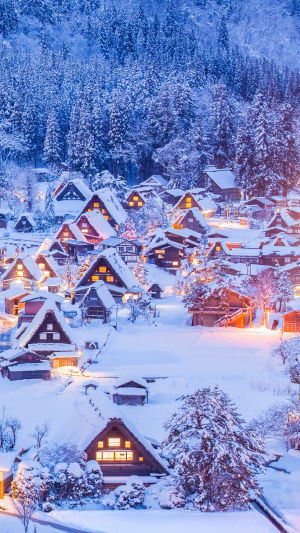Shirakawa-go and Goeyama Historical Villages is the collective name given to the historic villages of Shirakawa-go and Goeyama in the Hida region of Japan.
Located in a remote mountain valley in the central part of Honshu, the main island of Japan, Shirakawa-go and Goeyama historical villages have long been isolated from the rest of the world, and the unique feature of each town is the traditional architecture of the Japanese countryside.
Despite the enormous economic changes, these villages are still examples of traditional lifestyles combined with the local living environment and social functions.
Here is an introduction to this beautiful village.
Shirakawa-go and Goeyama-maize are located in a mountainous area.
The inhabitants of these villages make their living by growing mulberry and raising silkworms. The local farmhouses are distinctive and unique in Japan in that they are slightly larger than the average farmhouse, with two-story structures with steep roof slopes and covered with thatch.
Despite the severe economic turmoil, the villages of Ogimachi, Acura, and Suganuma still embody the traditional way of life of the local people, perfectly adapted to their natural and socio-economic environment.
There is nothing more valuable than the vitality of Shirakawa-go's Haphazo. Unlike most World Heritage sites, it has not become a pure tourist attraction, and hundreds of villagers still live in Shirakawa-go.
The villagers are still living in Shirakawa-go, a simple and peaceful place far from the hustle and bustle of the city.
Four seasons in Shirakawa-go
In spring, when the snowy white coat is removed and the land is revived, the cherry blossoms in Shirakawa-go begin to bloom continuously as the Open Farming Festival is held, and the spring breeze makes the pink cherry blossoms fly, giving you a sense of the vibrant spring.
In summer, the grass grows greener, and the flowers bloom just right, making it quietly pleasant. The crisp weather after the plum comes out and you can look up on the summer nights and see a sky full of stars.
With the sound of insects chirping, it is a rare time to cool off in a haphazard house deep in nature.
In autumn, the festival kicks off with a bang, and Shirakawa-go is gradually dressed in red.
In mid to late November, the most beautiful foliage is seen, with the forests and thatched roofs reflecting the colours of a watercolour painting. And the clouds curled up, adding a touch of mystery.
Winter is the most beautiful season in Hepao Village, Shirakawa Township. Every year from late December to early March is the snow season, during which the village holds a lighting ceremony.
The biggest event of the winter season is the 'lighting ceremony'. The lights are so popular that there are so many visitors that it causes serious traffic jams.
What else can you do in Shirakawa-go besides watching the lanterns?
1. Listen to the sounds of nature at the Shirakawago Aikawa Bridge
The 107m-long suspension bridge over the Shokawa River is located next to the Gifu bus stop in Shirakawa-go, and it offers a beautiful view of both sides of the Shokawa River to the eye and the sound of birdsong and water to the ear.
2. Discover the lives of the ancient Japanese at the Wada and Kanda houses
The Wada House, one of the many houses in Hapo Village in Shirakawa-go, was built at the end of the Edo period and is a "National Important Cultural Property", making it the largest and most representative Hapo house in Hapo Village.
Another place worth visiting to showcase the construction of the Hapu house is the Kanda house, where homemade herbal tea is served free of charge.





